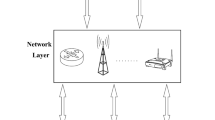Abstract
The flourish of mobile communications is driven by the increasing number of subscribers and rapid advance of electronic devices. This brings up many multimedia context-aware services, among which real time locating system (RTLS) has become necessary in many applications. To locate a mobile station (MS), RTLS could apply conventional fingerprinting algorithm using received signal strength indicator (RSSI), which allows a MS to collect RSSI data from beacons sent by access points (APs). However, this method does not work for iPhones because of the lack of open access to Apple application programming interface (API) to obtain RSSI values. This paper proposes an alternative approach, under which APs in the monitoring mode are used to collect RSSI values for semi-beacon packets sent from a MS. We implement the packet capture library, which enables us to obtain RSSI values of semi-beacon packets sent by an iPhone. With a region-based k-nearest neighbor (kNN) localization algorithm, we successfully locate an iPhone user in indoor environment. In addition, experimental results show that the proposed approach outperforms the conventional RSSI fingerprinting approach.








Similar content being viewed by others
References
Hightower, J., & Borriello, G. (2001). Location systems for ubiquitous computing. Computer, 34(8), 57–66.
American National Standards Institute. (2003). Real Time Locating Systems (rtls)-part 1: 2.4 Ghz-air interface protocol.
Ni, L. M., Liu, Y, Lau Y. C., & Patil, A. P. LANDMARC: indoor location sensing using active RFID. In IEEE PerCom’03 (pp. 407–415).
Bahl, P., & Padmanabhan, V. N. RADAR: an in-building rf-based user location and tracking system. In IEEE INFOCOM’00 (Vol. 2, pp. 775–784).
Priyantha, N. B., Chakraborty, A., & Balakrishnan, H. (2000). The cricket location-support system. In ACM MobiCom’00 (pp. 32–43). Boston, Massachusetts, USA, 6–11 August
Patwari, N., Ash, J. N., Kyperountas, S., Hero, A. O., Moses, R. L., & Correal, N. S. (2005). Locating the nodes: Cooperative localization in wireless sensor networks. IEEE Signal Processing Magazine, 22(4), 54–69.
Rong, P., & Sichitiu, M. L. (2006). Angle of arrival localization for wireless sensor networks. In IEEE SECON’06 (Vol. 1, pp. 374–382).
Xiao, W., Ni, W., & Toh, Y. K. Integrated WiFi fingerprinting and inertial sensing for indoor positioning. In IEEE IPIN’11 (pp. 1–6).
Kaemarungsi, K. (2006). Distribution of WLAN received signal strength indication for indoor location determination. In First international symposium on wireless pervasive computing (pp. 1–6).
Honkavirta, V., Perala, T., Ali-Loytty, S., & Piche, R. (2009). A comparative survey of WLAN location fingerprinting methods. In WPNC’09 6th workshop on positioning, navigation and communication (pp. 243–251).
Ahmad, T., Li, X. J., & Seet, B.-C. (2017). Parametric loop division for 3D localization in wireless sensor networks. Sensors, 17(7), 1–32.
Kumaresan, R., & Tufts, D. W. (1983). Estimating the angles of arrival of multiple plane waves. IEEE Transactions on Aerospace and Electronic Systems, AES–19(1), 134–139.
Niculescu, D., & Badri, N. (2003). Ad hoc positioning system (APS) using AOA. In Proceedings of IEEE INFOCOM’03 (pp. 1734–1743), San Francisco, CA, USA, 30 March–3 April.
Spirito, M. A. (2001). On the accuracy of cellular mobile station location estimation. IEEE Transactions on Vehicular Technology, 50(3), 674–685.
Gardner, W. A., & Chen, C. K. (1992). Signal-selective time-difference-of-arrival estimation for passive location of man-made signal sources in highly corruptive environments, Part I: Theory and method. IEEE Transactions on Signal Processing, 40(5), 1168–1184.
Niculescu, D., & Nath, B. (2001). Ad hoc positioning system (APS). In Proceedings of IEEE GLOBECOM ’01 (pp. 2926–2931), San Antonio, TX, USA, 25–29 Nov.
Niculescu, D., & Nath, B. (2003). DV based positioning in ad hoc networks. Telecommunication Systems, 22(1), 267–280.
He, T., Huang, C., Blum, B. M., Stankovic, J. A., & Abdelzaher T. (2003). Range-free localization schemes for large scale sensor networks. In Proceedings of ACM MobiCom’03 (pp. 81–95), San Diego, CA, USA, 14–19 September.
Sun, G., Chen, J., Guo, W., & Liu, K. J. R. (2005). Signal processing techniques in network-aided positioning: A survey of state-of-the-art positioning designs. IEEE Signal Processing Magazine, 22(4), 12–23.
Kaemarungsi, K., & Krishnamurthy, P. (2004). Modeling of indoor positioning systems based on location fingerprinting. In Proceedings of IEEE INFOCOM’04 (pp. 1012–1022), Hong Kong SAR, China, 7–11 March.
Lim, H., Kung, L. C., Hou, J. C., & Luo, H. (2006). Zero-configuration, robust indoor localization: Theory and experimentation. In Proceedings of IEEE INFOCOM’06 (pp. 1–12), Barcelona, Spain, 23–29 April.
Varshavsky, A., Pankratov, D., Krumm, J., & Lara, E. (2008). Calibree: Calibration-free localization using relative distance estimations. In Proceedings of PerCom’08 (pp. 146–161), Sydney, Australia, 19–22 May.
Xie, Y., Wang, Y., Nallanathan, A., & Wang, L. (2016). An improved K-nearest-neighbor indoor localization method based on Spearman distance. IEEE Signal Processing Letters, 23(3), 351–355.
Tian, X., Wang, M., Li, W., Jiang, B., Xu, D., & Wang, X. (2018). Improve accuracy of fingerprinting localization with temporal correlation of the RSS. IEEE Transactions on Mobile Computing, 17(1), 113–126.
Wen, Y., Tian, X., Wang, X., & Lu, S. (2015). Fundamental limits of RSS fingerprinting based indoor localization. In Proceedings of IEEE INFOCOM’15 (pp. 2479–2487), Hong Kong SAR, China, 26 April–1 May.
He, S., & Chan, S. H. G. (2016). WiFi fingerprint-based indoor positioning: Recent advances and comparisons. IEEE Communications Surveys & Tutorials, 18(1), 466–490.
Zdziarski, J. (2009). iPhone SDK application development: Building applications for the AppStore. Newton: O’Reilly Media.
Installation of iPhone Apps in real iOS device. (2012). https://help.apple.com/xcode/mac/current/#/dev7ccaf4d3c.
Network Socket Programming. (2012). https://www.raywenderlich.com/157128/real-time-communication-streams-tutorial-ios.
Installation and Configuration of OpenWrt. (2012). https://wiki.openwrt.org/doc/howto/basic.config.
libpcap packet capture tutorial. (2012). http://eecs.wsu.edu/~sshaikot/docs/lbpcap/libpcap-tutorial.pdf.
OpenWrt versions. (2012). https://wiki.openwrt.org/about/latest.
Gu, Y., Lo, A., & Niemegeers, I. (2009). A survey of indoor positioning systems for wireless personal networks. IEEE Communications Surveys & Tutorials, 11(1), 13–32.
Youssef, M. A., Agrawala, A., & Shankar, A. Udaya WLAN location determination via clustering and probability distributions. In IEEE PerCom’03 (pp. 143–150).
Acknowledgements
This work was supported by the internal research project funding in the Department of Networking Protocols, Institute of Infocomm Research (I2R), A*STAR, Singapore. The authors would like thank Dr. Yunye Jin, Dr. Wendong Xiao and Mr. Yue Khing Toh for their help and fruitful discussions.
Author information
Authors and Affiliations
Corresponding author
Additional information
Publisher's Note
Springer Nature remains neutral with regard to jurisdictional claims in published maps and institutional affiliations.
Rights and permissions
About this article
Cite this article
Li, X.J., Bharanidharan, M. RSSI Fingerprinting Based iPhone Indoor Localization System Without Apple API. Wireless Pers Commun 112, 61–74 (2020). https://doi.org/10.1007/s11277-019-07015-4
Published:
Issue Date:
DOI: https://doi.org/10.1007/s11277-019-07015-4




